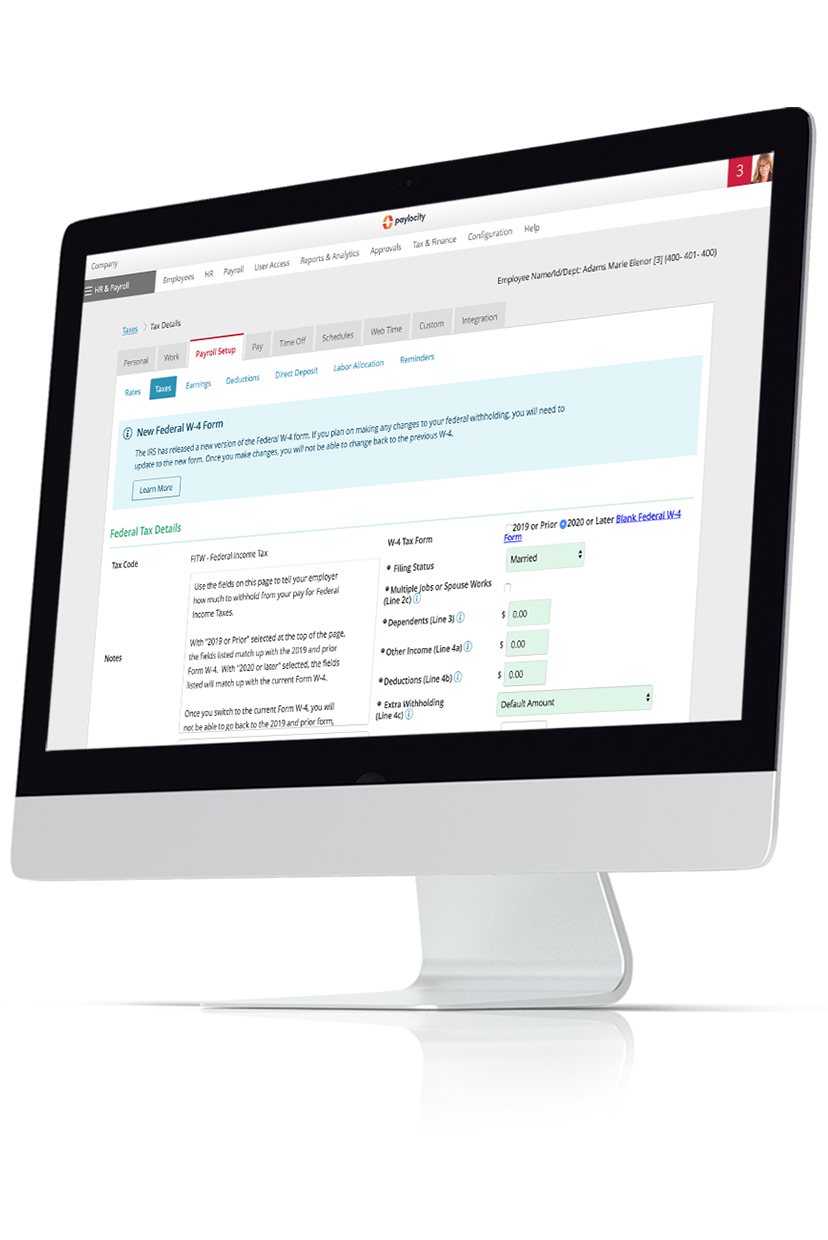What is SUTA Tax? State Unemployment Tax Explained
January 21, 2025
The State Unemployment Tax Act (SUTA) funds programs and benefits for unemployed citizens. Get current state rates and answers to FAQs.
- Reviewed by Paylocity's Compliance & Government Relations Team

What is SUTA?
The State Unemployment Tax Acts (SUTA) or state unemployment insurance (SUI) is a state payroll tax that funds programs and benefits for unemployed citizens. This tax provides temporary financial relief to those actively seeking new employment.
Also known as a contribution rate, or reemployment tax, this payroll tax is in addition to the Federal Unemployment Tax Act (FUTA) which helps fund programs and benefits for unemployed citizens.
The SUTA, or SUI, tax rate varies from state to state, but what companies pay generally is based on how many unemployment claims they've had in the past. The funds collected from these taxes go to help unemployed workers bridge the gap until their next job.
Note: The below information was last updated January 21, 2025. It is not intended as legal or tax advice.
Key Takeaways
- SUTA or SUI is a state payroll tax that funds state programs for unemployed citizens.
- Since SUI is enforced at the state level, the amount ranges by state.
- Unlike Medicare and Social Security, only employers are responsible for paying SUI except in three states.
Are SUTA and SUI the Same Tax?
Because each state determines their own state unemployment tax act, the rates and terms for it can vary by state. This tax can be referred to as any of the following:
- State Unemployment Tax Acts (SUTA)
- State Unemployment Insurance (SUI)
- Contribution tax
- Reemployment tax
- Unemployment benefit tax
Regardless of which term is used, it's a mandatory state tax. This tax is used when a former employee is provided a temporary wage from the state’s agency until they successfully find a new position or the end of the time period allotted.
Who Pays SUTA/SUI?
Like FUTA, employers almost always pay SUI themselves. Typically, if you owe FUTA, you will also owe SUTA. You are subject to this tax if you have one or more employees, rather than 1099 contractors, who work 20 or more weeks during a calendar year. The weeks do not need to be consecutive, and wages need to be paid at least $1,500. However, there are three states in which employees are also responsible for paying a portion of these taxes:
- Alaska
- New Jersey
- Pennsylvania
Some states also have exemptions for certain types of companies, such as nonprofit or charity organizations such as 501(C)(3). While laws do vary by state, organizations that fall under these categories are exempt and do not have to pay SUTA. Employers are not typically required to pay for workers under 21.
How to Calculate SUI
SUI rates are calculated by a percentage of the prescribed wage base limit, which is the maximum amount of an employee’s annual gross income that can be used. When calculating SUI, several things are considered:
- How long the company has been in business
- High turnover or seasonality of your industry
- The number of unemployment claims filed
SUI also incentivizes employers not to lay off and fire a high proportion of their employees by reducing tax amounts for companies with low turnover. Some states have separate ranges for seasonal industries such as construction because of the industry’s high rate of employee turnover. You can look up your state tax rate with the table below or on your state's website.
How to File & Pay SUI
While the IRS requires Form 940 to be filed with all FUTA deposits, most states require different forms. You can find out which form your state requires on your state’s website. Most employers pay their SUI either monthly or quarterly, but the requirements on payment frequency can vary.
You’ll need to register with the states in which you operate and where your employees are based. Log on to your state’s website to obtain an account. After an account is set up, you’ll be issued an employer identification number (EIN) and your new employer contribution rate. You’ll need your federal EIN to set up an account. You can find your federal EIN by contacting the IRS.
2025 SUI Rates by State
It’s important to note that SUI rates are paid to the state where employees work, which is not necessarily the same state the company is headquartered. If an employee works in multiple states, the employer should determine the state for which unemployment insurance is paid. This can be based on where they work, where they receive their direction or where they live depending on the circumstances. Learn more on your state's tax website or unemployment agency.
|
Jurisdiction |
Taxable Wage base |
Jurisdiction |
Taxable Wage base |
|---|---|---|---|
|
Alabama |
$8,000 |
Montana |
$45,100 |
|
Alaska |
$51,700 |
Nebraska |
$9,000 |
|
Arizona |
$8,000 |
Nevada |
$41,800 |
|
Arkansas |
$7,000 |
New Hampshire |
$14,000 |
|
California |
$7,000 |
New Jersey |
$43,300 |
|
California SDI |
No Limit |
New Jersey TDI EE |
$165,400 |
|
Colorado |
$27,200 |
New Mexico |
$33,200 |
|
Connecticut |
$26,100 |
New York |
$12,800 |
|
Delaware |
$12,500 |
North Carolina |
$32,600 |
|
District of Columbia |
$9,000 |
North Dakota |
$45,100 |
|
Federal |
$176,100 |
Ohio |
$9,000 |
|
Florida |
$7,000 |
Oklahoma |
$28,200 |
|
Georgia |
$9,500 |
Oregon |
$54,300 |
|
Hawaii |
$62,000 |
Pennsylvania |
$10,000 |
|
Idaho |
$55,300 |
Puerto Rico |
$7,000 |
|
Illinois |
$13,916 |
Rhode Island |
$29,800 |
|
Indiana |
$9,500 |
South Carolina |
$14,000 |
|
Iowa |
$39,500 |
South Dakota |
$15,000 |
|
Kansas |
$14,000 |
Tennessee |
$7,000 |
|
Kentucky |
$11,700 |
Texas |
$9,000 |
|
Louisiana |
$7,700 |
Utah |
$48,900 |
|
Maine |
$12,000 |
Vermont |
$14,800 |
|
Maryland |
$8,500 |
Virgin Islands |
$31,100 |
|
Massachusetts |
$15,000 |
Virginia |
$8,000 |
|
Michigan |
$9,500 |
Washington |
$72,800 |
|
Minnesota |
$43,000 |
West Virginia |
$9,500 |
|
Mississippi |
$14,000 |
Wisconsin |
$14,000 |
|
Missouri |
$9,500 |
Wyoming |
$32,400 |
SUTA FAQs
Are SUTA and SUI the same?
Yes! Because each state sets up its own tax, you may hear it referred to differently. It’s referred to as any of the following: state unemployment tax acts (SUTA), state unemployment insurance (SUI), contribution tax, reemployment tax, or unemployment benefit tax.
Do I have to pay both SUTA and FUTA taxes?
Yes, unless you are exempt. FUTA is a federal payroll tax and SUTA is a state payroll tax.
How do I know if my organization is exempt?
Certain organizations, such as government employers, nonprofit religious, charitable, and educational institutions are exempt. Review your state’s website for more information.
If my company has multiple locations, to which state do I pay SUTA taxes?
If you have multiple locations or employees who work remotely in multiple states, you will need to file in each state where an employee completes the majority of her or his work. Each employee should only be assigned one state for benefits to be paid. See section above for details.
What If I overpay SUTA taxes?
You will be refunded or credited for any overage paid.
How do I file state taxes?
Check your state’s agency website for details on which forms are required to file and when.
Simplify SUTA Taxes with Paylocity
Many payroll software companies make these payments on behalf of their clients with withheld amounts. A leading HR and payroll provider can simplify tax compliance and ensure your taxes are paid on time. Request a Demo today to see how Paylocity can help you simplify your tax payments!

Get Taxes Done Right, Without the Stress
We know there's a lot that goes into preparing and filing payroll tax forms. Save time and get support from our expert team. As a Registered Reporting Agent with the IRS, we can help prepare and file all the necessary forms you need to remain compliant - even in the face of changing legislation. Learn more here.
